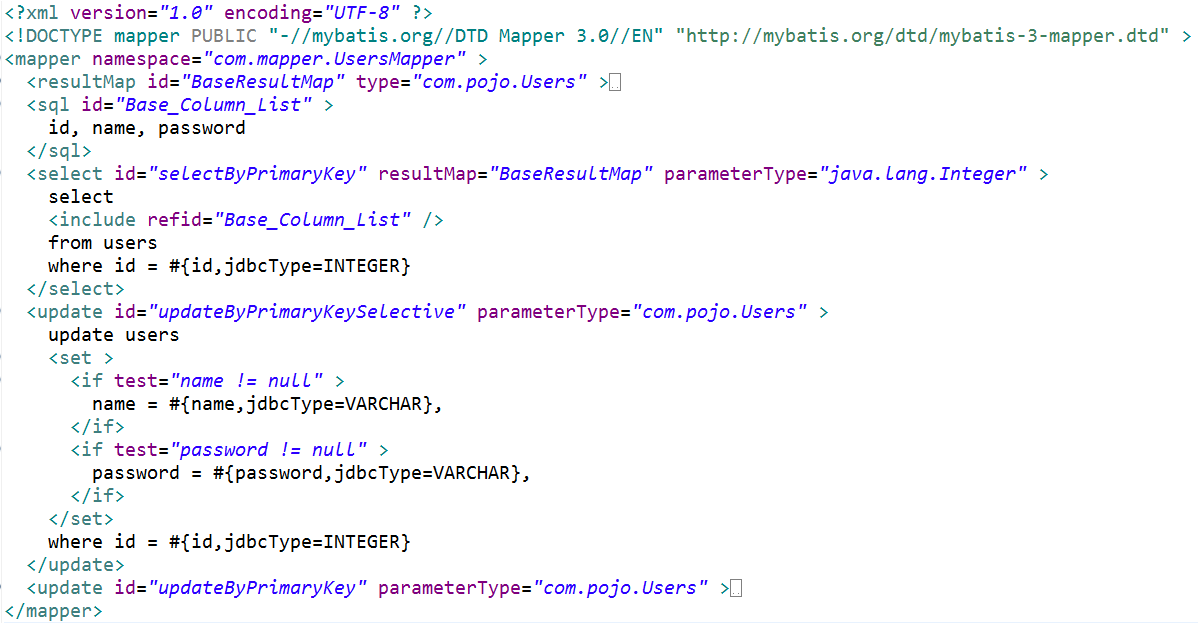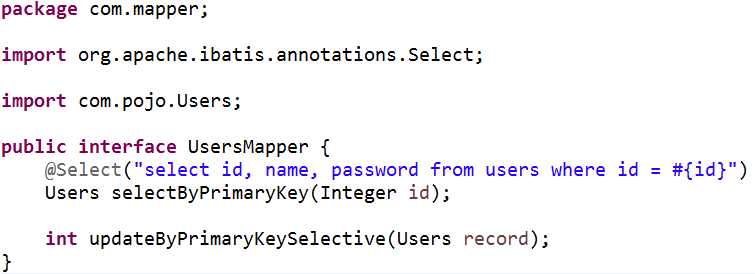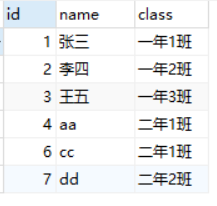MyBatis学习存档(4)——进行CRUD操作
使用MyBatis进行数据库的CRUD操作有2种方式:一种如之前所说的接口+xml,而另一种是通过对接口上的方法加注解(@Select @Insert @Delete @Update)
但是通常情况下不建议使用注解进行操作,原因在于MyBatis最强大的特性在于其动态sql,若使用注解则无法使用动态sql
因此此处仅仅对注解进行简单的举例
一、注解
<?xml version="1.0" encoding="UTF-8" ?>
<!DOCTYPE mapper PUBLIC "-//mybatis.org//DTD Mapper 3.0//EN" "http://mybatis.org/dtd/mybatis-3-mapper.dtd" >
<mapper namespace="com.mapper.UsersMapper" >
<resultMap id="BaseResultMap" type="com.pojo.Users" >
<id column="id" property="id" jdbcType="INTEGER" />
<result column="name" property="name" jdbcType="VARCHAR" />
<result column="password" property="password" jdbcType="VARCHAR" />
</resultMap>
<sql id="Base_Column_List" >
id, name, password
</sql>
<select id="selectByPrimaryKey" resultMap="BaseResultMap" parameterType="java.lang.Integer" >
select
<include refid="Base_Column_List" />
from users
where id = #{id,jdbcType=INTEGER}
</select>
<update id="updateByPrimaryKeySelective" parameterType="com.pojo.Users" >
update users
<set >
<if test="name != null" >
name = #{name,jdbcType=VARCHAR},
</if>
<if test="password != null" >
password = #{password,jdbcType=VARCHAR},
</if>
</set>
where id = #{id,jdbcType=INTEGER}
</update>
<update id="updateByPrimaryKey" parameterType="com.pojo.Users" >
update users
set name = #{name,jdbcType=VARCHAR},
password = #{password,jdbcType=VARCHAR}
where id = #{id,jdbcType=INTEGER}
</update>
</mapper>
UsersMapper.xml
package com.mapper;
import org.apache.ibatis.annotations.Select;
import com.pojo.Users;
public interface UsersMapper {
@Select("select id, name, password from users where id = #{id}")
Users selectByPrimaryKey(Integer id);
int updateByPrimaryKeySelective(Users record);
}
UsersMapper.java


依旧以之前反向生成的UsersMapper为例,为显得简洁些,仅保留了2个方法:selectByPrimaryKey和updateByPrimaryKeySelective
打上注解的方法selectByPrimaryKey,其注解效果和xml中的一致,但updateByPrimaryKeySelective方法却无法打上注解,原因无它,该方法使用了动态sql,而注解中无法使用动态sql
二、接口+xml
为了之后好举例,此处重新创建了一个名为student的表,并反向生成了映射文件和实体类,并进行了些许改动
2.1 创建student表并反向生成映射文件和实体类
sql语句如下:
CREATE TABLE student(id INT PRIMARY KEY identity(1,1), name VARCHAR(20), class VARCHAR(20));
反向生成步骤不再多说
2.2 更改映射文件和实体类
反向生成后会发现实体类Student报错了,点开发现在class处报错——class是java的关键字
所以我们应当将class改成clazz,这样就不会报错了
仅仅更改实体类是不够的,还需将映射xml中对应的字段进行修改
最后对接口及xml进行一定的更改,最终结果如下
package com.mapper;
import com.pojo.Student;
public interface StudentMapper {
//通过id删除学生
int deleteById(Integer id);
//添加学生
int insertStudent(Student record);
//通过id查找学生
Student selectById(Integer id);
}
StudentMapper.java
<?xml version="1.0" encoding="UTF-8" ?>
<!DOCTYPE mapper PUBLIC "-//mybatis.org//DTD Mapper 3.0//EN" "http://mybatis.org/dtd/mybatis-3-mapper.dtd" >
<mapper namespace="com.mapper.StudentMapper" >
<resultMap id="BaseResultMap" type="com.pojo.Student" >
<id column="id" property="id" jdbcType="INTEGER" />
<result column="name" property="name" jdbcType="VARCHAR" />
<result column="class" property="clazz" jdbcType="VARCHAR" />
</resultMap>
<sql id="Base_Column_List" >
id, name, class
</sql>
<!-- 通过id查找学生 -->
<select id="selectById" resultMap="BaseResultMap" parameterType="java.lang.Integer" >
select
<include refid="Base_Column_List" />
from student
where id = #{id,jdbcType=INTEGER}
</select>
<!-- 通过id删除学生 -->
<delete id="deleteById" parameterType="java.lang.Integer" >
delete from student
where id = #{id,jdbcType=INTEGER}
</delete>
<!-- 添加学生 -->
<insert id="insertStudent" parameterType="com.pojo.Student" >
insert into student (name, class)
values (#{name,jdbcType=VARCHAR}, #{clazz,jdbcType=VARCHAR})
</insert>
</mapper>
StudentMapper.xml
package com.pojo;
public class Student {
private Integer id;
private String name;
private String clazz;
public Integer getId() {
return id;
}
public void setId(Integer id) {
this.id = id;
}
public String getName() {
return name;
}
public void setName(String name) {
this.name = name == null ? null : name.trim();
}
public String getClazz() {
return clazz;
}
public void setClazz(String clazz) {
this.clazz = clazz == null ? null : clazz.trim();
}
@Override
public String toString() {
return "Student [id=" + id + ", name=" + name + ", clazz=" + clazz + "]";
}
}
Student.java
2.3 对数据库进行CRUD操作
1、首先添加一个学生,代码如下:
package com.test; import java.io.InputStream; import org.apache.ibatis.io.Resources;
import org.apache.ibatis.session.SqlSession;
import org.apache.ibatis.session.SqlSessionFactory;
import org.apache.ibatis.session.SqlSessionFactoryBuilder; import com.mapper.StudentMapper;
import com.pojo.Student; public class TestInsert { public static void main(String[] args) throws Exception {
//mybatis的核心配置文件
String resource = "mybatis-config.xml";
//使用MyBatis提供的Resources类加载mybatis的配置文件
InputStream is = Resources.getResourceAsStream(resource);
//构建SqlSession的工厂
SqlSessionFactory factory = new SqlSessionFactoryBuilder().build(is);
//开启SqlSession
SqlSession session = factory.openSession();
//通过映射接口执行操作
StudentMapper mapper = session.getMapper(StudentMapper.class);
//new一个名叫张三 一年1班的学生
Student stu = new Student();
stu.setName("张三");
stu.setClazz("一年1班");
try {
mapper.insertStudent(stu);
//提交
session.commit();
} catch (Exception e){
//回滚
session.rollback();
System.out.println("添加失败");
} finally {
session.close();
}
System.out.println("添加成功");
} }
结果:可以从日志中看到sql语句及传入的参数,最后输出“添加成功”

在数据库里查看下添加的结果:确实多了一条数据

为了之后方便操作,在此可以多添加几条数据:

2、查询指定id的学生,代码如下:
package com.test; import java.io.InputStream; import org.apache.ibatis.io.Resources;
import org.apache.ibatis.session.SqlSession;
import org.apache.ibatis.session.SqlSessionFactory;
import org.apache.ibatis.session.SqlSessionFactoryBuilder; import com.mapper.StudentMapper;
import com.pojo.Student; public class TestSelect { public static void main(String[] args) throws Exception {
//mybatis的核心配置文件
String resource = "mybatis-config.xml";
//使用MyBatis提供的Resources类加载mybatis的配置文件
InputStream is = Resources.getResourceAsStream(resource);
//构建SqlSession的工厂
SqlSessionFactory factory = new SqlSessionFactoryBuilder().build(is);
//开启SqlSession
SqlSession session = factory.openSession();
//通过映射接口执行操作
StudentMapper mapper = session.getMapper(StudentMapper.class);
Student student = mapper.selectById(1);
System.out.println(student);
session.close();
} }
结果如下:

3、删除指定id的学生,代码如下:
package com.test; import java.io.InputStream; import org.apache.ibatis.io.Resources;
import org.apache.ibatis.session.SqlSession;
import org.apache.ibatis.session.SqlSessionFactory;
import org.apache.ibatis.session.SqlSessionFactoryBuilder; import com.mapper.StudentMapper; public class TestDelete { public static void main(String[] args) throws Exception {
//mybatis的核心配置文件
String resource = "mybatis-config.xml";
//使用MyBatis提供的Resources类加载mybatis的配置文件
InputStream is = Resources.getResourceAsStream(resource);
//构建SqlSession的工厂
SqlSessionFactory factory = new SqlSessionFactoryBuilder().build(is);
//开启SqlSession
SqlSession session = factory.openSession();
//通过映射接口执行操作
StudentMapper mapper = session.getMapper(StudentMapper.class);
try {
mapper.deleteById(5);
//提交
session.commit();
} catch (Exception e){
//回滚
session.rollback();
System.out.println("删除失败");
} finally {
session.close();
}
System.out.println("删除成功");
} }
结果如下:

现在再看数据库中的数据,发现id为5的学生已经不见了:

4、更改指定id的学生姓名
此时,StudentMapper里并没有update相关的方法,所以需要手动添加方法。现在接口中定义updateStudentById方法,然后在xml中编写相应的节点:使用update节点,id与方法名一致,传入参数类型为Student类,节点内为sql语句
package com.mapper;
import com.pojo.Student;
public interface StudentMapper {
//通过id删除学生
int deleteById(Integer id);
//添加学生
int insertStudent(Student record);
//通过id查找学生
Student selectById(Integer id);
//更改指定id学生的姓名
int updateStudentById(Student student);
}
StudentMappe.java
<?xml version="1.0" encoding="UTF-8" ?>
<!DOCTYPE mapper PUBLIC "-//mybatis.org//DTD Mapper 3.0//EN" "http://mybatis.org/dtd/mybatis-3-mapper.dtd" >
<mapper namespace="com.mapper.StudentMapper" >
<resultMap id="BaseResultMap" type="com.pojo.Student" >
<id column="id" property="id" jdbcType="INTEGER" />
<result column="name" property="name" jdbcType="VARCHAR" />
<result column="class" property="clazz" jdbcType="VARCHAR" />
</resultMap>
<sql id="Base_Column_List" >
id, name, class
</sql>
<!-- 通过id查找学生 -->
<select id="selectById" resultMap="BaseResultMap" parameterType="java.lang.Integer" >
select
<include refid="Base_Column_List" />
from student
where id = #{id,jdbcType=INTEGER}
</select>
<!-- 通过id删除学生 -->
<delete id="deleteById" parameterType="java.lang.Integer" >
delete from student
where id = #{id,jdbcType=INTEGER}
</delete>
<!-- 添加学生 -->
<insert id="insertStudent" parameterType="com.pojo.Student" >
insert into student (name, class)
values (#{name,jdbcType=VARCHAR}, #{clazz,jdbcType=VARCHAR})
</insert>
<!-- 更改指定id学生的姓名 -->
<update id="updateStudentById" parameterType="com.pojo.Student">
update student set name = #{name} where id = #{id}
</update>
</mapper>
StudentMapper.xml
编写测试类,先从数据库中查询获得需要修改的学生信息,再更改其姓名,最后提交
package com.test; import java.io.InputStream; import org.apache.ibatis.io.Resources;
import org.apache.ibatis.session.SqlSession;
import org.apache.ibatis.session.SqlSessionFactory;
import org.apache.ibatis.session.SqlSessionFactoryBuilder; import com.mapper.StudentMapper;
import com.pojo.Student; public class TestUpdate { public static void main(String[] args) throws Exception {
//mybatis的核心配置文件
String resource = "mybatis-config.xml";
//使用MyBatis提供的Resources类加载mybatis的配置文件
InputStream is = Resources.getResourceAsStream(resource);
//构建SqlSession的工厂
SqlSessionFactory factory = new SqlSessionFactoryBuilder().build(is);
//开启SqlSession
SqlSession session = factory.openSession();
//通过映射接口执行操作
StudentMapper mapper = session.getMapper(StudentMapper.class);
Student student = mapper.selectById(4);
System.out.println(student);
student.setName("赵六");
try{
mapper.updateStudentById(student);
//提交
session.commit();
} catch (Exception e){
//回滚
session.rollback();
System.out.println("更改失败");
}
System.out.println("更改成功");
session.close();
} }
结果和数据库如下:


5、现更改需求:更改指定id学生所在的班级
又多了一个update的需求,需要再新增一个方法吗?并不需要,只需在updateStudentById方法对应的映射sql中进行更改就可以了,这时就可以用到动态sql了
<!-- 更改指定id学生的姓名 -->
<update id="updateStudentById" parameterType="com.pojo.Student">
update student
<set>
<if test="name != null">
name = #{name} ,
</if>
<if test="clazz != null">
class = #{clazz} ,
</if>
</set>
where id = #{id}
</update>
将update节点改为上述,再编写测试类
package com.test; import java.io.InputStream; import org.apache.ibatis.io.Resources;
import org.apache.ibatis.session.SqlSession;
import org.apache.ibatis.session.SqlSessionFactory;
import org.apache.ibatis.session.SqlSessionFactoryBuilder; import com.mapper.StudentMapper;
import com.pojo.Student; public class TestUpdate { public static void main(String[] args) throws Exception {
//mybatis的核心配置文件
String resource = "mybatis-config.xml";
//使用MyBatis提供的Resources类加载mybatis的配置文件
InputStream is = Resources.getResourceAsStream(resource);
//构建SqlSession的工厂
SqlSessionFactory factory = new SqlSessionFactoryBuilder().build(is);
//开启SqlSession
SqlSession session = factory.openSession();
//通过映射接口执行操作
StudentMapper mapper = session.getMapper(StudentMapper.class);
Student student = new Student();
student.setId(4);
student.setClazz("三年1班");
System.out.println(student);
try{
mapper.updateStudentById(student);
//提交
session.commit();
} catch (Exception e){
//回滚
session.rollback();
System.out.println("更改失败");
}
System.out.println("更改成功");
session.close();
} }
先new一个Student,再set它的id和class,此时name为null,执行update操作

可以看见执行的sql为update student SET class = ? where id = ?
如果我们将name的值set为aaa,再看执行的sql语句:

可以看见执行的sql为update student SET name = ? , class = ? where id = ?
这就是动态sql,除了if外,还有choose (when, otherwise),trim (where, set),foreach,这些节点的使用方式与JSTL标签的使用类似
三、动态sql
3.1 if
最简单的节点,只需配置test属性即可,test内为布尔表达式,为true时if语句块中的sql语句才会存在,且不会对sql进行任何变动,因此有时会出现多逗号、and、or、where的情况,通常与对应的节点使用,如set、where等
3.2 choose (when, otherwise)
choose节点下有2个子节点when和otherwise,when节点中有1个属性test,和if的类似
该节点的语法与if...else if...else类似
<choose>
<when test="表达式1">
sql语句1
</when>
<when test="表达式2">
sql语句2
</when>
<otherwise>
sql语句3
</otherwise>
</choose>
例如上述例子,当表达式1为true时,有且仅有sql语句1会被执行,不会有2和3;当表达式1、2都不满足时,就会执行sql语句3
3.3 trim
有4个属性:prefix、suffix、prefixOverrides、suffixOverrides。它可以更灵活地去除多余关键字,可以替代where和set
以2.5中的sql语句为例,可变更如下,效果是一样的:
<!-- 更改指定id学生的姓名 -->
<update id="updateStudentById" parameterType="com.pojo.Student">
update student
<trim prefix="set" suffixOverrides="," suffix="where id = #{id}">
<if test="name != null">name = #{name},</if>
<if test="clazz != null">class = #{clazz},</if>
</trim>
</update>
3.4 foreach
用于迭代一个集合,通常用于in条件,其属性如下:
item:集合名称(传入的变量名)
index:指定迭代次数的名称
collection:必须指定,表示传入的集合是什么类型的
list
array
map-key
open:语句的开始
separator:每次循环的分割符
close:语句的结束
MyBatis学习存档(4)——进行CRUD操作的更多相关文章
- Mybatis学习(二) - CRUD操作(增删改查操作)
直接上例子: 1.项目结构: 2.具体代码及配置 User.java package com.mybatis.bean; public class User { private int id; pri ...
- MyBatis学习存档(3)——mapper.xml映射文件
MyBatis 真正的强大在于映射语句,专注于SQL,功能强大,SQL映射的配置却是相当简单 所以我们来看看映射文件的具体结构 一.xml节点结构 mapper为根节点 - namespace命名空间 ...
- Mybatis基于代理Dao实现CRUD操作 及 Mybatis的参数深入
Mybatis基于代理Dao实现CRUD操作 使用要求: 1.持久层接口和持久层接口的映射配置必须在相同的包下 2.持久层映射配置中mapper标签的namespace属性取值必须是持久层接口的全限定 ...
- 使用MyBatis对数据库中表实现CRUD操作(二)
一.使用MyBatis对表实现CRUD操作 1.定义sql映射 userMapper.xml <?xml version="1.0" encoding="UTF-8 ...
- Springboot整合Mybatis实现级联一对多CRUD操作
在关系型数据库中,随处可见表之间的连接,对级联的表进行增删改查也是程序员必备的基础技能.关于Spring Boot整合Mybatis在之前已经详细写过,不熟悉的可以回顾Spring Boot整合Myb ...
- Spring Boot整合Mybatis完成级联一对多CRUD操作
在关系型数据库中,随处可见表之间的连接,对级联的表进行增删改查也是程序员必备的基础技能.关于Spring Boot整合Mybatis在之前已经详细写过,不熟悉的可以回顾Spring Boot整合Myb ...
- MyBatis学习 之 六、insert操作返回主键
数据库操作怎能少了INSERT操作呢?下面记录MyBatis关于INSERT操作的笔记,以便日后查阅. 二. insert元素 属性详解 其属性如下: parameterType ,入参的全 ...
- MyBatis学习存档(5)——联表查询
之前的数据库操作都是基于一张表进行操作的,若一次查询涉及到多张表,那该如何进行操作呢? 首先明确联表查询的几个关系,大体可以分为一对一和一对多这两种情况,接下来对这两种情况进行分析: 一.建立表.添加 ...
- MyBatis学习存档(1)——入门
一.简介 MyBatis的前身是iBatis,本是Apache的一个开源的项目 MyBatis是一个数据持久层(ORM)框架,把实体类和SQL语句之间建立了映射关系,是一种半自动化的ORM实现 MyB ...
随机推荐
- 主机,路由器,应用程序,sockets api的关系
- 全网最新Kali Linux系统如何安装N卡驱动
转载请注明来源:全网最新Kali Linux系统如何安装N卡驱动[亲测-暗影精灵3-1050TI有效] - 大家好,我系渣渣辉 https://www.zzhsec.com/255.html 1.更换 ...
- navicat连接远程数据库报错'client does not support authentication protocol requested by server consider ...'解决方案
[1.cmd终端连接远程mysql数据库方法] mysql -uhello -pworld -h192.168.1.88 -P3306 -Dmysql_oa mysql -u用户名 -p密码 -h ...
- MapReduce Combiner
Combiner编程(可选步骤,视情况而定!) combiner最基本是实现本地key的归并,combiner具有类似本地的reduce功能. 如果不用combiner,那么所有的结果都是reduce ...
- 性能分析 | Java进程CPU占用高导致的网页请求超时的故障排查
一.发现问题的系统检查: 一个管理平台门户网页进统计页面提示请求超时,随进服务器操作系统检查load average超过4负载很大,PID为7163的进程占用到了800%多. 二.定位故障 根据这种故 ...
- Vue于React特性对比(三)
最近重学React,再次和vue做了对比. 一,为官方插件提供便利的第三方插件横行 React仅仅是一个ui框架.虽然官方提供了redux,react-router:但也有第三方的redux-thun ...
- linux下如何交叉编译util-linux?
1. 获取源码 wget https://mirrors.edge.kernel.org/pub/linux/utils/util-linux/v2.34/util-linux-2.34.tar.xz ...
- IPv6地址表示方式
1.IPv6 简介 IPv6是英文“Internet Protocol version 6”(互联网协议第6版)的缩写,是互联网工程任务组(IETF)设计的用于替代IPv4的下一代IP协议,其地 ...
- 一条语句kill 多条mysql语句
If information_schema.processlist doesn’t exist on your version of MySQL, this works in a linux scri ...
- Ubuntu+Django+uWSGI+Nginx部署Django项目
安装uWSGI,pip依据自己要使用的python版本自行选择,python2.x版本使用pip进行安装,python3.x版本使用pip3进行安装 pip install uwsgi 配置uWSGI ...
